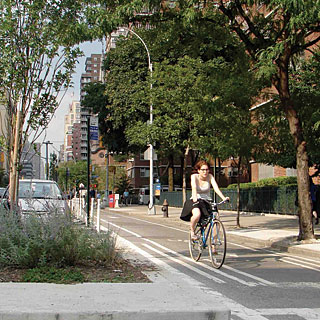Getting people out of cars and onto bicycles, a much more sustainable form of transportation, has long vexed environmentally conscious city planners. Although bike lanes painted on streets and automobile-free “greenways” have increased ridership over the past few years, the share of people relying on bikes for transportation is still less than 2 percent, based on various studies. An emerging body of research suggests that a superior strategy to increase pedal pushing could be had by asking the perennial question: What do women want?
In the U.S., men’s cycling trips surpass women’s by at least 2:1. This ratio stands in marked contrast to cycling in European countries, where urban biking is a way of life and draws about as many women as men—sometimes more. In the Netherlands, where 27 percent of all trips are made by bike, 55 percent of all riders are women. In Germany 12 percent of all trips are on bikes, 49 percent of which are made by women.
“If you want to know if an urban environment supports cycling, you can forget about all the detailed ‘bikeability indexes’—just measure the proportion of cyclists who are female,” says Jan Garrard, a senior lecturer at Deakin University in Melbourne, Australia, and author of several studies on biking and gender differences.
Women are considered an “indicator species” for bike-friendly cities for several reasons. First, studies across disciplines as disparate as criminology and child rearing have shown that women are more averse to risk than men. In the cycling arena, that risk aversion translates into increased demand for safe bike infrastructure as a prerequisite for riding. Women also do most of the child care and household shopping, which means these bike routes need to be organized around practical urban destinations to make a difference.
“Despite our hope that gender roles don’t exist, they still do,” says Jennifer Dill, a transportation and planning researcher at Portland State University. Addressing women’s concerns about safety and utility “will go a long way” toward increasing the number of people on two wheels, Dill explains.
So far few cities have taken on the challenge. In the U.S., most cycling facilities consist of on-street bike lanes, which require riding in vehicle-clogged traffic, notes John Pucher, a professor of urban planning at Rutgers University and longtime bike scholar. And when cities do install traffic-protected off-street bike paths, they are almost always along rivers and parks rather than along routes leading “to the supermarket, the school, the day care center,” Pucher says.
Although researchers have long examined the bike infrastructure in Europe, they have only just started to do so for the U.S. In a study conducted last year, Dill examined the effect of different types of bike facilities on cycling. The project, which used GPS positioning to record individual cycling trips in Portland, compared the shortest route with the path cyclists actually took to their destination. Women were less likely than men to try on-street bike lanes and more likely to go out of their way to use “bike boulevards,” quiet residential streets with special traffic-calming features for bicycles. “Women diverted from the shortest routes more often,” Dill says.
Other data support those findings. In New York City, men are three times as likely to be cyclists as women. Yet a bicycle count found that an off-street bike path in Central Park had 44 percent female riders. “Within the same city you find huge deviations in terms of gender,” Pucher remarks.
Good infrastructure alone won’t improve women’s cycling rates, researchers caution. In an automobile-dominated culture, “attitudinal variables” also play a role, says Susan Handy, a professor of environmental science at the University of California, Davis. In a survey to be published in Transportation Research Record, Handy found that “comfort” and “needing a car” were important factors influencing women’s cycling rates—but not men’s. Needing a car is likely tied to the household errands women often perform, Handy says, and could be addressed in part by outreach programs showing that women can “jump on a bike the way they jump in a car.”

A few municipalities are beginning to implement a “second wave” of strategies aimed at broadening the cycling demographic. In Portland, a city already renowned for its urban cycling, a Women on Bikes program targets such concerns as fixing a flat tire. The city is also building its first cycle track—a European-style bike lane that is separated from cars and pedestrians. Across the country state and federally funded Safe Routes to Schools programs are creating practical bike routes for kids so they don’t have to be driven by their parents.
Ahead of the curve may be New York City, where about five miles of traffic-protected bike lanes have recently been installed. Credit goes to the new Department of Transportation commissioner Janette Sadik-Khan, who is upending the department’s long-standing focus on trucks and automobiles. Remarks Pucher: “A woman cyclist became head of the DOT, and wonderful things started happening.”
From Scientific American
